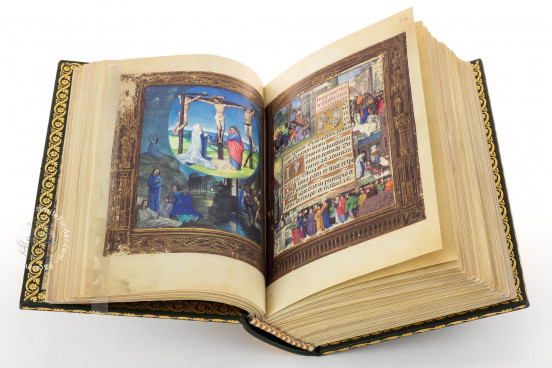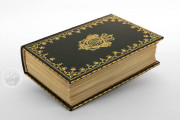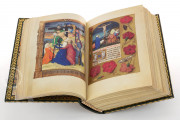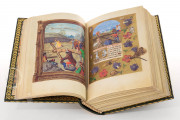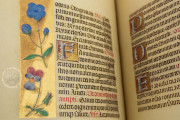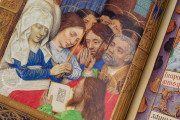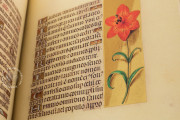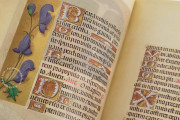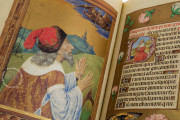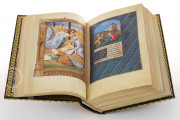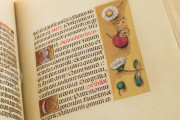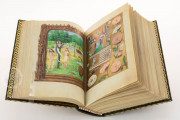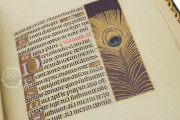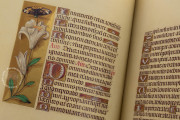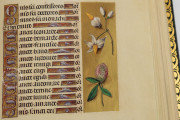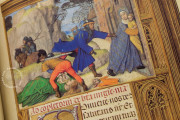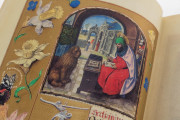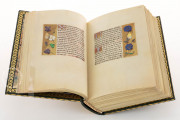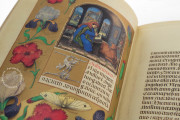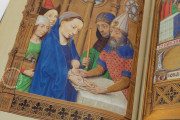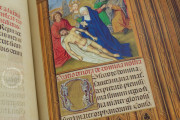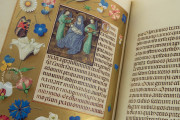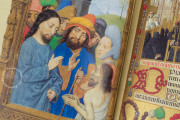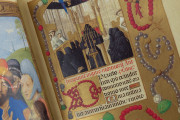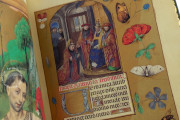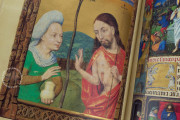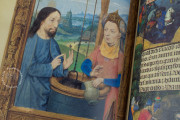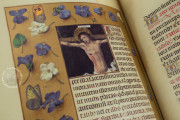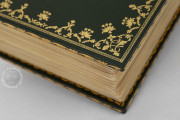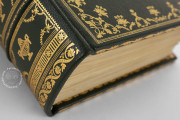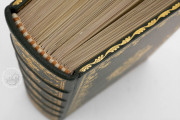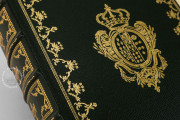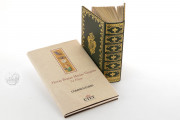The La Flora Hours offers a collection of stunning images in a diversity of compositions and an intriguing puzzle concerning its genesis. Twenty-two full-page miniatures were painted by Simon Marmion in Valenciennes before 1489, and the manuscript was completed—with the participation of several masters of the Ghent-Bruges school—in Bruges and possibly also Ghent before 1498. Its astonishingly rich program of decoration includes thirty-six full-page, twenty-eight half-page, and thirty smaller miniatures; twenty-four bas-de-page calendar miniatures; and a full-page coat of arms.
The book features an unusual devotional program, which in turn prompted some pictorial subjects that rarely appear in books of hours. The manuscript owes its sobriquet to its sumptuous borders featuring both elaborate architectural frames and an extensive assortment of blooms and butterflies, dragonflies, and other insects.
The Dramatic Close-Up
La Flora is particularly renowned for Simon Marmion's miniatures that feature the "dramatic close-up," a striking compositional tool that reached its height in late fifteenth-century Flemish illumination. While Marmion had previously devised compositions in this format, the La Flora Hours is considered the principal witness to its greatest mastery, and its cycle of miniatures had a marked impact on subsequent artistic generations.
Masters of the Ghent-Bruges School
The remaining dozens of miniatures in the manuscript are attributed to the Master of the Dresden Prayer Book, the Master of the First Prayer Book of Maximilian and his workshop, and the Master of the Prayer Books of around 1500, all of whom worked in the prevailing naturalistic style of late fifteenth-century Flemish illumination.
Unusual Pictorial Subjects
Among the subjects rarely found in books of hours are Christ and the Samaritan Woman (fol. 284v), the Trial of Susanna (fol. 289v), and the Supper at Emmaus (fol. 295v), all by Simon Marmion. Also unusual are the historiated borders by the Master of the Dresden Prayer Book devoted to Daniel and the Punishment of the Elders (fol. 290r) and the Tiburtine Sibyl, Moses and the Burning Bush, and the Miraculous Fleece of Gideon (fol. 263r).
Patchwork Construction
The manuscript was manifestly created over the course of at least two campaigns. It seems that Marmion's miniatures were coopted from a project that was abandoned and incorporated into a new and very expansive project. While work was collaborative, physical evidence demonstrates that the book was pieced together: a majority of the miniatures, including all of Marmion's, were trimmed to the edges and mounted onto pages supplied with painted borders.
A Single Scribe
The manuscript's text was written in Gothic Textualis, the preferred script for devotional texts, by a single scribe. Major textual divisions are often introduced by a full-page miniature with fictive sculptural frame on a verso facing an incipit page with a half-page miniature, a decorated initial, a rubric, and the text's beginning, also with a full border.
An Ambitious Project for an Unknown Patron
The original patron of this monumental commission remains, as is often the case, completely unknown. The unusual subjects featured in some miniatures suggest a patron with specific and singular devotional requirements. The image dedicated to the Old Testament story of Susanna might indicate a female patron.
A History of Illustrious Owners
Very early in its history, the manuscript was in the possession of Charles VIII (1470-1498), King of France, whose full-page coat of arms appears on fol. 2v. It was owned by members of the Farnese family by 1637, and through Elizabeth Farnese (1692-1766), consort of Philip V, King of Spain, came into the possession of Charles III (1716-1788), King of Spain. Charles had it transferred to the library in the newly built Palazzo Reale in Naples in 1754.
Neapolitan Binding
The manuscript was bound shortly thereafter: the gold-tooled green morocco binding was probably made in the workshop of Angelo Trani and bears the arms of Ferdinand I (1751-1825), King of the Two Sicilies. The Reale Biblioteca Borbonica, as the library of the Palazzo Reale was known at the time, became the Biblioteca Nazionale Vittorio Emanuele III in 1860.
We have 1 facsimile edition of the manuscript "La Flora Hours": Flora (Horae Beatae Mariae Virginis) facsimile edition, published by De Agostini/UTET, 2008
Request Info / Price

